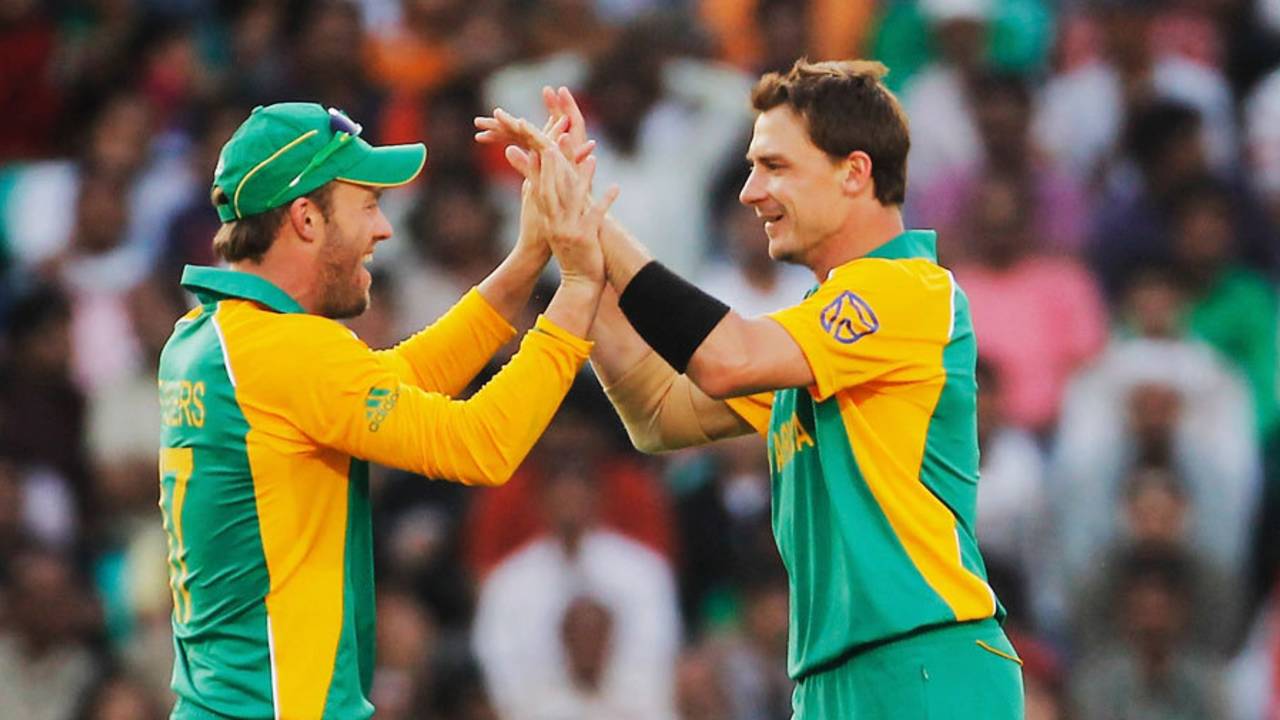How can we stop 400 becoming the new 300?
It's time the ICC took steps to empower bowlers in ODIs for the sake of the balance of power in the game
Michael Jeh
15-May-2015
If de Villiers can bat for most of an innings, why can't Steyn bowl for a third of one? • Getty Images
The almost routine predictability of ODI cricket was more apparent in the recent World Cup than in any previous tournament I can recall.
Much of this could be attributed to the way the rules are configured to favour batsmen. Two new balls, shorter boundaries, bigger bats, Powerplays, regular scrutiny of the no-ball when a wicket falls, the benefit of the doubt frequently going to the batsman when low catches are claimed.
When you add some atrocious death bowling, usually from the part-time bowlers, it's no surprise that so many batting innings finished with a huge flourish. Over 100 runs in the last ten overs was almost par for the course. Two opening batsmen scored double-hundreds and it seemed like there were so many more big centuries from the top order than before.
Yet arguably the two best teams with the deepest batting orders, Australia and New Zealand, played twice on flat wickets for two first-innings scores in the 150-200 range. The Auckland game, in particular, was expected to produce close to 400 for the team batting first, but it turned out to be just a tick over 300 in total for 19 wickets lost. Pressure and good swing bowling can confound the best-laid plans.
Aberrations aside, though, if ODI cricket is to remain at the cutting edge of innovation, it needs a radical overhaul in terms of a re-calibration of the playing conditions. Most new ideas are initially greeted with shock, but once they have been trialled and tinkered with, the better ones are invariably adopted.
Think back to the initial reaction when two new balls were mooted. Too much in favour of the bowlers, they said, but history has proved that, if anything, it has helped batting teams.
Other trials haven't stood the test of time. Australian domestic cricket toyed with the idea of a 12-man team, with an inter-change player, but that was deemed too far removed from the purity of the basics of the game. Martin Crowe tried to introduce a version of the game that encouraged batsmen to hit straight and double their score, but it never quite caught on in senior cricket.
Restrict four bowlers to 10 overs each but give one the opportunity to fight fatigue and bowl a third of the available overs. It's still less than the 50-60% of balls that an opening batsman will face if he bats all through
One of the problems apparent in the last World Cup was the hemorrhaging that occurred towards the end of an innings, usually brought about by the fifth or sixth bowlers being unable to sustain the early pressure of the best bowlers. West Indies v Zimbabwe, South Africa v Zimbabwe and South Africa v West Indies were cases in point where the team bowling first could not capitalise on slowish starts by the opposition. The carnage at the end defied description, aided by a healthy serving of full tosses to players of the calibre of AB de Villiers, David Miller, Chris Gayle, Darren Sammy and JP Duminy.
What if you allowed one bowler to bowl a maximum of 16 overs (33% of the innings)? If there is no restriction on how many balls the best batsmen can face, why do we place an artificial restriction on the best bowlers? When Gayle plundered his double-century against Zimbabwe, he was reprieved early on by the DRS for a close lbw call and went on to bat for the rest of the innings. Martin Guptill too was allowed to bat the full 50 overs. So why not allow the best bowler to bowl more than the obligatory ten overs?
By all means restrict four bowlers to 10 overs each but give one bowler the opportunity to fight fatigue and bowl a third of the available overs. It's still less than the 50-60% of balls that an opening batsman will face if he bats through the innings, but at least it gives the fielding side some chance of maintaining a modicum of control through those late overs when boundaries are raining down on the spectators.
Imagine a situation where a Saeed Ajmal (when in form) can keep bowling instead of handing the ball to someone like Haris Sohail and watching it go to custard.
Or why not have a rule then that forces batsmen to retire after they face 100 balls (33% of the innings) and return again after the ninth wicket has fallen? That presents the batting team with a fascinating conundrum: do you risk getting bowled out so your best player can come back in? Will he still be in the same touch after a short break? If you think back to de Villiers in that epic semi-final against New Zealand, when he returned after the rain break, he barely faced another ball, and when he did, the boundaries dried up. In hindsight, that break in his innings cost South Africa dearly.
Yes, I admit that the flaw in my argument comes back to the age-old truism that it only takes one mistake to end a batsman's day at the crease. Fair point too. There will never be a perfect solution, but empowering the bowling team is something the ICC needs to consider if 400 is not going to soon become the old 300.
Michael Jeh is an Oxford Blue who played first-class cricket, and a Playing Member of the MCC. He lives in Brisbane
